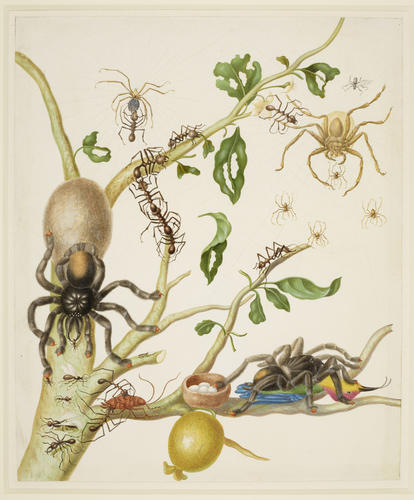-
1 of 253523 objects
Branch of Guava tree with Army Ants, Pink-Toe Tarantulas, Huntsman Spiders, and Ruby-Topaz Hummingbird 1702-03
Watercolour and bodycolour with gum arabic over lightly etched outlines on vellum | 39.0 x 32.3 cm (whole object) | RCIN 921172

Maria Sibylla Merian (1647-1717)
Branch of Guava tree with Army Ants, Pink-Toe Tarantulas, Huntsman Spiders, and Ruby-Topaz Hummingbird 1702-03
-
A watercolour of a branch from a Guava tree (Psidium guineense) with Army Ants (Eciton sp.), Pink-Toed Tarantulas (Avicularia avicularia), Hunstman Spiders (Heteropoda venatoria) and a Ruby-Topaz Hummingbird (Chrysolampis mosquitus). This is a version of plate 18 in Merian's Metamorphosis Insectorum Surinamensium. In her text, Merian described the behaviour of the insects closely, noting how even humans fled the movement of swarms of ants through houses. She also described the activity of Leaf-Cutter Ants, noting that they 'can eat whole trees bare as a broom handle in a single night' [translation from Elizabeth Rücker and William T. Stearn, Maria Sibylla Merian in Surinam, London 1982]. The composition includes a tarantula carrying off a hummingbird. The Latin name of the tarantula genus is Avicularia - ‘small bird’ - referring to the spiders’ supposed diet. However, tarantulas do not prey on birds, and it has even been suggested that the reputation arose because of Merian’s memorable image.
Maria Sibylla Merian was the daughter of the printmaker Matthias Merian, and the step-daughter of the still-life painter Jacob Marrel. She was a talented artist, who was trained in flower painting by Marrel. From an early age, she was fascinated by insects and their life cycles, and undertook research into the phenomenon of metamorphosis, which was then only partially understood. She published her findings in a series of books, illustrated with beautifully-composed plates in which each insect life-cycle was illustrated on the appropriate food plant. In 1699, having encountered exotic insects in the cabinets of natural history collectors in Amsterdam, Merian and her younger daughter Dorothea set sail for Suriname, in South America, which was then a Dutch colony. There, they studied the life cycles of Surinamese insects until their return to Europe in 1701. Merian published her Surinamese research as the Metamorphosis Insectorum Surinamensium (The Metamorphosis of the Insects of Suriname) in 1705. The book was very well-received, and by her death Merian was well-regarded throughout Europe as both an entomologist and an artist.
This is one of a set of luxury versions of the plates from Merian's Metamorphosis Insectorum Surinamensium, published in Amsterdam in 1705. To make these versions, Merian (probably assisted by her daughters) appears to have inked sections of each etched plate and run it through the press to create a partial print. While the ink of that print was still wet, she placed a sheet of vellum against it, transferring a reverse image onto the vellum. This ‘counterproof’ was then worked up and coloured by hand. The Royal Collection plates are partially printed and partially hand-drawn, the printing mainly being used for the insects. As Merian was only transferring selected areas of the printed image, she could vary the arrangements of the plates, with the positions of the butterflies and moths subtly altered to create unique compositions.Provenance
Dr Richard Mead (1673–1754); his sale (London, Abraham Langford, 13–16 January 1755, lot 66), where purchased by an unknown collector; sold 15 June 1768 (London, Paterson and Eve, lot 572), where purchased by Sir John Hill via Wilson; George III by c.1810
-
Creator(s)
Acquirer(s)
-
Medium and techniques
Watercolour and bodycolour with gum arabic over lightly etched outlines on vellum
Measurements
39.0 x 32.3 cm (whole object)
Object type(s)
Other number(s)
RL 21172Alternative title(s)
Plate 18 to Metamorphosis Insectorum Surinamensium